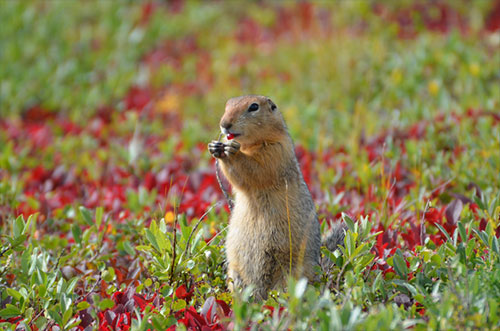A juvenile arctic ground squirrel foraging near |
Arctic ground squirrels survive harsh Alaska winters by hibernating for over half the year, drastically slowing their lungs, heart, brain, and body functions. They still must spend energy to generate enough heat from stored fat to keep tissues from freezing. They resurface from their burrows more than 3 feet below the ground each spring, famished and eager to mate.
Chmura and Williams, along with co-authors, analyzed long-term air and soil temperature data at two sites in Arctic Alaska in conjunction with data collected using biologgers. They measured abdominal and/or skin temperature of 199 free-living individual ground squirrels over the same 25-year period. They found that females are changing when they end hibernation, emerging earlier every year, but males are not. Changes in females match earlier spring thaw. The advantage of this phenomenon is that they do not need to use as much stored fat during hibernation and can begin foraging for roots and shoots, berries and seeds sooner in the spring. Scientists think this could lead to healthier litters and higher survival rates.
The downside is that if the males also do not shift hibernation patterns, there eventually could be a mismatch in available “date nights” for the males and females. Ground squirrels are also an important source of food for many predators, such as foxes, wolves, and eagles. An indirect consequence of being active above ground longer is greater exposure and risk of being eaten.
What will happen to the population is a big unknown – there are not clear winners or losers. While hibernation requires less energy, which could help overwinter survival, ground squirrel numbers also depend on how predators respond to climate shifts. For now, Williams concludes, “Our paper shows the importance of long-term datasets in understanding how ecosystems are responding to climate change.” Chmura agreed, adding, “It takes a great team to continue a dataset like this for 25 years, especially in the Arctic.”
Other contributing authors include Brian Barnes, University of Alaska Fairbanks, and Loren Buck from Northern Arizona University, who both began this study in the 1990s to learn how Arctic ground squirrels survive such long, cold, dark, winters and just how cold their hibernation spots were. These questions prompted them to install the first soil temperature monitors, and as technology improved, they were able to measure those temperatures all winter long. Cassandra Duncan and Grace Burrell assisted with the research with students at the University of Alaska Fairbanks.
Related Journal:
Science: Climate change is altering the physiology and phenology of an arctic hibernator
Source of News:
Colorado State University
www.colostate.eduU.S. Forest Service Rocky Mountain Research Station
www.usda.gov
Representations of fact and opinions in comments posted are solely those of the individual posters and do not represent the opinions of Sitnews.
Send a letter to the editor@sitnews.us
SitNews ©2023
Stories In The News
Ketchikan, Alaska
Articles & photographs that appear in SitNews are considered protected by copyright and may not be reprinted without written permission from and payment of any required fees to the proper freelance writers and subscription services.
E-mail your news & photos to editor@sitnews.us
Photographers choosing to submit photographs for publication to SitNews are in doing so granting their permission for publication and for archiving. SitNews does not sell photographs. All requests for purchasing a photograph will be emailed to the photographer.

